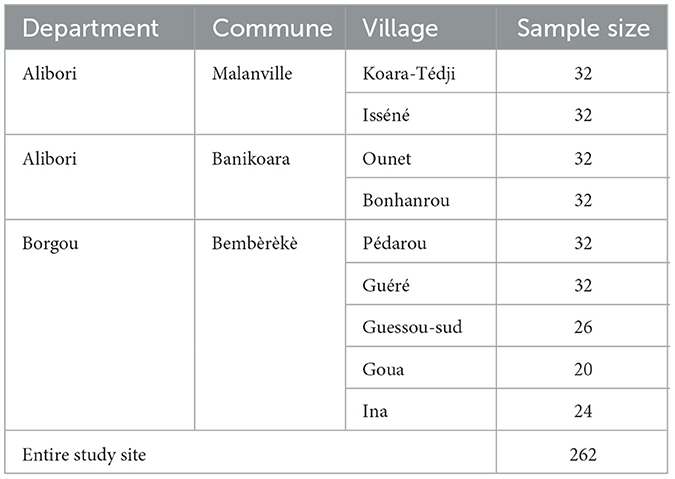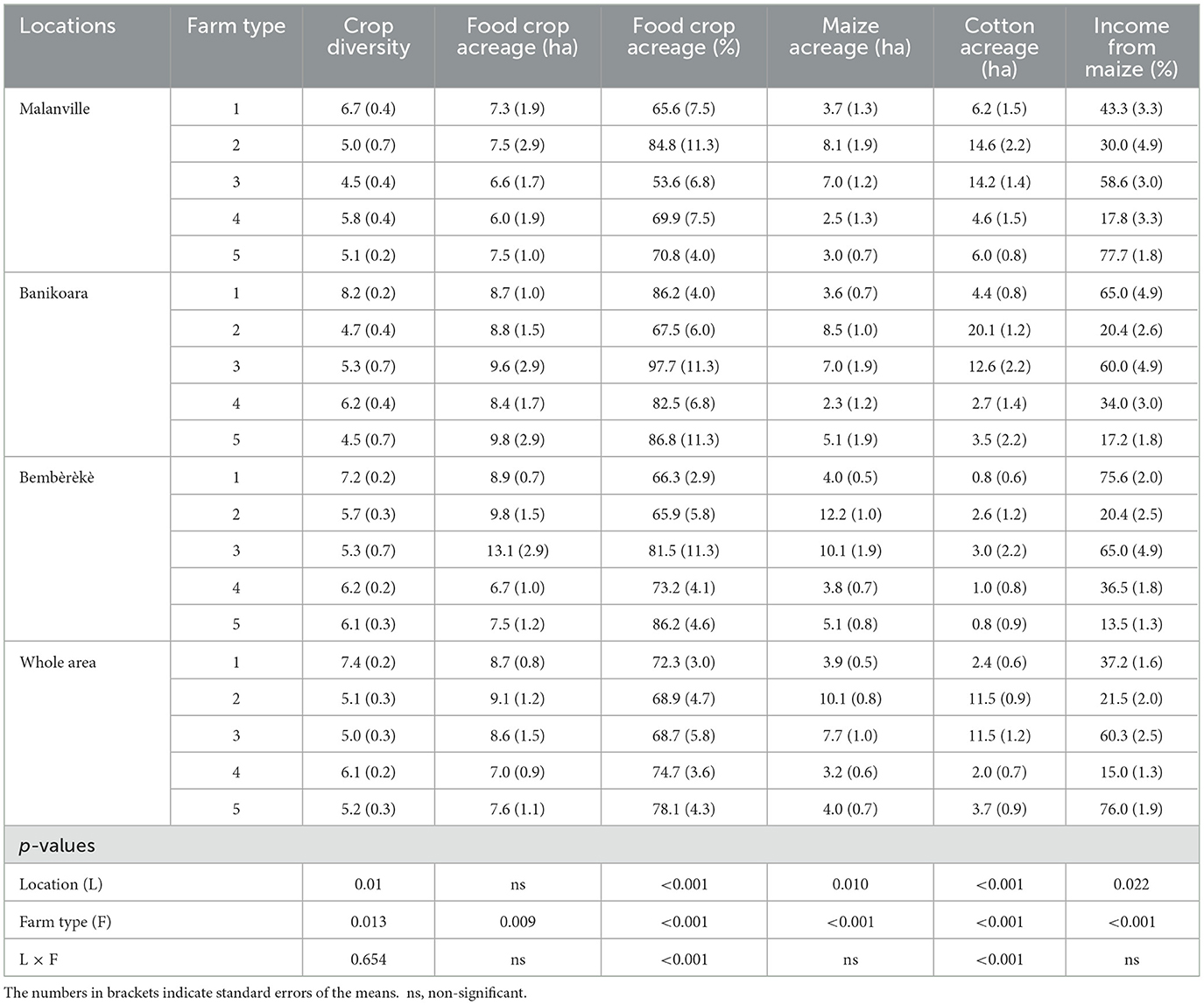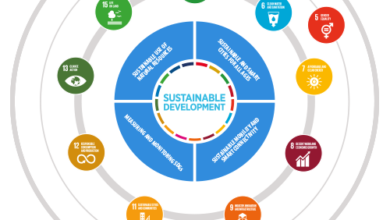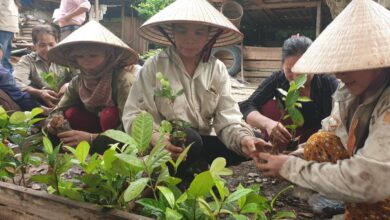Resource endowment and sustainable soil fertility management strategies in maize farming systems in northern Benin
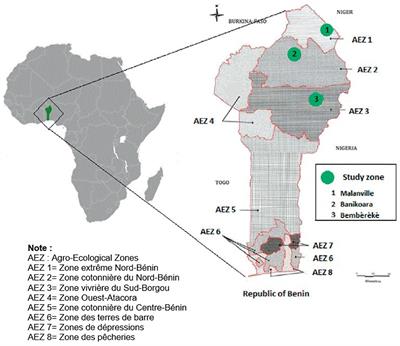
1 Introduction
In sub-Saharan Africa (SSA), the majority of the population lives in rural areas and relies on agriculture for their livelihoods. This sector accounts for about 30%−50% of the gross domestic product, represents the main source of income for more than 60% of the population, and provides over 40% of export earnings (FAOSTAT, 2020). More than 90% of the food produced in the African continent is grown by smallholder farmers, mostly under rain-fed conditions. However, despite the promising prospects that agriculture offers for sustainable development, Africa’s agricultural productivity is still low compared to other countries in the world, leading to chronic food insecurity (Smale et al., 2013). Indeed, the average yield of most cereals is low, ranging from 0.5 to 1.5 t ha−1 (FAOSTAT, 2020). Besides changing climate patterns, poor soil fertility is viewed as one of the major constraints to crop production and poverty as a result of the low intrinsic soil fertility, nutrient mining practices, limited and inadequate organic resources, and low investment capacity in external inputs (Barrett and Bevis, 2015; Vanlauwe et al., 2015).
As in many parts of SSA, the economy of Benin is essentially based on agriculture. Among all cereals, maize (Zea mays L.) is the most important staple crop and source of calories in the diets of the population. It occupies about 82% of the total land area under cereals and accounts for about 84% of cereal production (INSAE, 2013). The farming systems in Benin, like in SSA, are predominantly rain-fed and dominated by smallholder subsistence producers and pastoralists (Livingston et al., 2011; Smale et al., 2011). Maize production has been growing (from 219,593 tons in 1961 to 1,509,758 tons in 2018; FAOSTAT, 2020) due to increasing demand from neighboring countries as a result of cultivated area expansion (from 375,650 to 968,030 ha during the same period). In the framework of the Strategic Plan for Strengthening the Agricultural Sector, maize is considered a strategic crop for improving the livelihoods of smallholder farmers (PSDSA, 2017). Thus, increasing maize productivity would be interesting by increasing export revenues and thereby improving national and domestic food security. Despite its central role, maize productivity remains low, usually below 1.5 t ha−1 and well below its potential yields (3–5 t ha−1). Among all possible constraints, soil fertility depletion is the most severe threat to food security, sustainable agricultural production, and rural development in the country (Saïdou et al., 2004; Srivastava, 2010). It is mostly the result of mismanagement of agricultural land and historical dynamics of the political-ecological system and regional land policies (Carsky et al., 2001; Yemadjè et al., 2012).
For a long time, maize production and consumption were confined to the southern parts of the country, but now it has extended to the northern regions. Increasingly, the northern part of Benin is increasingly considered the basket of food (maize, soybean, yam, sorghum, and millet) and cash crops (cotton). In this region, climate variability and change have further contributed to low productivity in recent years (Tidjani and Akponikpè, 2012; Yegbemey et al., 2014; Akossou et al., 2016). Given the importance of maize for both food security and the rural economy in Benin and because opportunities for expanding cultivated land are often limited to marginal lands, improving its production cannot solely come from area expansion but also from productivity gains through appropriate management techniques that can restore and maintain the quality of agricultural land and narrow the yield gap. Previous research showed that the farm structure and farming practices in SSA are very diverse, and therefore, generic farm management recommendations do not work (Tittonell et al., 2005, Tittonell et al., 2007; Zingore et al., 2007). Management interventions require a good understanding of the farming systems and the diversity of socioeconomic situations to develop context-specific and targeted recommendations for sustainable intensification of the cropping systems (Bongers et al., 2015). In particular, several studies have shown that resource availability (land, labor, and cash) influences the adoption potential of agricultural practices among smallholder farms in Africa (Tittonell et al., 2005a,b; Zingore et al., 2006; Bidogeza et al., 2009; Kamanga et al., 2009; Bongers et al., 2015). For instance, the choice of nutrient management practice is mainly based on the availability of resources at the farm level rather than on a systematic and intentional way to increase soil fertility (Mapfumo and Giller, 2001). Better knowledge of the cropping systems (resource availability, allocation, and use patterns) and existing soil fertility practices may thus help understand the adoption potential of recommended practices for different farm types to better target sustainable intensification efforts. Therefore, this study aims at (1) typifying and characterizing the maize farming systems by assessing the diversity in resource availability and allocation; (2) identifying farmers’ current soil fertility management strategies, including the use of recommended practices with a focus on manure, mineral fertilizer, and their integrated use; and (3) assess the opportunities and constraints for different farm types with maize production systems regarding the adoption potential of these practices in the future.
2 Materials and methods
2.1 Selection of study sites and observation units
The study was conducted in the departments of Borgou and Alibori, which cover three of the four agroecological zones (AEZ) in northern Benin. This region was selected based on the importance of maize farming. This area is the main food and cash crop production area of Benin. The rainfall distribution across the whole region is monomodal, characterized by a long dry season and a single rainy season between May and October that allows for only one cropping season per year. The sampling was conducted by using a hierarchical approach through a five-step procedure based on purposive (for selecting the municipal areas, villages, and farmers, i.e., maize farmers) and random techniques (for selecting the respondents). With the support of agricultural extension officers, the municipalities of Malanville, Banikoara, and Bembèrèkè in AEZs 1, 2, and 3, respectively, were selected (Figure 1). Within the three municipalities, two to four villages were selected that correspond to different administrative units of the municipalities considered. Within each village, 20–32 farmers were randomly sampled using a table of random numbers (Table 1). A total of 262 farmers were selected in the whole study area.
2.2 Household survey and data collection
The selected farmers were surveyed during the rainy season of 2014 (July–August). The collected information gathered during the structured interviews using the questionnaire included (a) socioeconomic characteristics (including age, education level of the farmer and their family members, main occupation, access to credit, and land ownership and the farm’s wealth) and income source and (b) the main farming system characteristics (total household members, farm size, and land property rights), farm assets (including labor availability, livestock ownership, and maize production system), the number of crop species grown each year, the number of cropped field areas, the number and type of animals owned (cattle, sheep, goats, and chicken), and farm machinery—family labor availability was calculated as the number of family laborers working full- or part-time in the farm and permanently hired laborers; and (c) soil management practices and current soil fertility management strategies, such as the quantity of applied fertilizers (manure and chemical fertilizers). The amount of manure quantity was expressed as the number of carts and translated to rates applied, assuming that one cart is equal to 976 kg of manure as proposed by Azouma et al. (2007).
Various sources of income were used to define the orientation of the farm. The percentage income from maize was obtained by dividing the income from maize production by the total income of the household (farm and non-farm activities), while the part of income from maize the in total expense of the household was estimated by asking the household head the contribution of maize production income to the total expenses of the household (%).
One focus group discussion was done per village with the local experts and extension officers. Participatory wealth ranking was used to identify the most relevant criteria that we could use to classify the farmers into different wealth classes and identify livelihood strategies.
2.3 Data analysis
The diversity of farming systems was analyzed through a farm typology following Tittonell et al. (2005a,b, 2010). This enables the categorization of different farm types with similar characteristics into specific farm clusters. Households were categorized according to their resources endowment and their main sources of income. Principal component analysis (PCA) was used to identify non-correlated socioeconomic indicators to use as proxies for the household categorization criteria, and households were grouped into homogeneous classes using agglomerative hierarchical clustering with Ward linkages (Husson et al., 2010). The PCA was conducted using 14 quantitative variables related to the characteristics of the household, labor, land use, livestock ownership, and household income (Table 2) to identify proxy indicators for the main drivers of livelihood strategies across localities. The loadings of the first most relevant principal components were examined for their bearings with meaningful indicators of the farm typology criteria. Variables with a significant factor loading (>0.70) were selected for input for the cluster analysis. Based on the resulting dendrogram, we divided our data set into five clusters with a minimum of 30 and a maximum of 90 farm households per cluster.
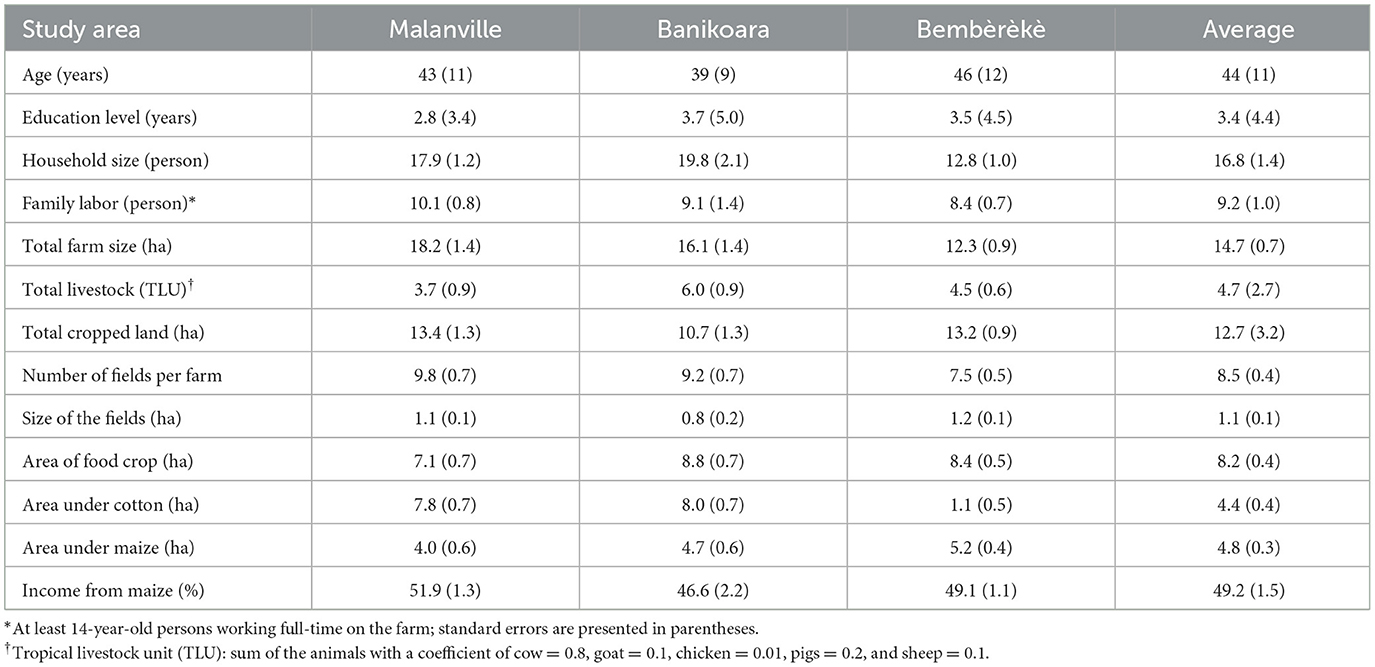
Table 2. Descriptive statistics (mean ± standard error in parentheses) of variables used for farm typology construction.
Comparisons across locations and farm types in terms of socioeconomic characteristics, land use, and management indicators were done by calculating descriptive statistics and analyzing the variance using SPSS software version 21.
The assessment of potential adoption of the improved soil fertility management practices was based on a comparative assessment of (1) what resources farmers have, (2) what management practices the farmers currently apply, and (3) what the requirements of these practices are.
3 Results
3.1 Farm typology and variability between farms
Households were grouped into five clusters considering the main drivers of livelihood strategies represented by proxy indicators derived through PCA at each site independently. Generally, the same pattern observed in the PCA at the regional scale was also observed at each site (data not shown). The PCA at the regional scale indicated that 62.6% of the household variability was explained by the first three principal components (PCs), which have high positive loadings, respectively, on farm size, household size, family labor, cropped land, total livestock owned, area food crop, number of cattle, and area under cotton (Supplementary Table S1). The contribution of the fourth and fifth PCs (income from maize and age) explained only a little of the remaining variation. The Kaiser-Meyer-Olkin (KMO) value was high (0.62), and a Bartlett’s test showed a significant difference at p < 0.0001, implying that the chosen set of variables was suitable for PCA. Eight variables have a factor loading >0.600 in the first three PCs and were selected to be used in the agglomerative hierarchical cluster analysis. Based on the dendrogram and the size of each cluster in the entire sample, the data set was divided into five clusters with a minimum of 30 and a maximum of 90 farm households per cluster.
Farm type 1: Farmers of type 1 are the poorest or medium-wealthy and the more “diversified farms” (seven different crop species grown). They have an average total farm size of 10.9 ha, of which 44.3 and 24.9% were cropped, respectively, with maize and cotton. This type of household has, on average, 13 household members, of which 54% work full-time on the farm. The farmer and their family members have no more than a primary school education (< 3 years of school). Farming is the primary occupation of all farmers. These farms obtain < 10% of their total household income from maize production. They obtain 37.2% of their total household income from maize and use about 45.9% of this maize income for household expenses. Farmers from this group also keep few livestock [3.1 tropical livestock unit (TLU)] and cattle (3.0 TLU) and have no farm machines. However, they own many hand-operated implements (12.0 on average), such as hoes and machetes, for farming. More than 50% of farms have a total annual revenue of less than US$1,000, and only 20% have a total revenue greater than US$2,000 per year.
Farm type 2: Farmers in this group belong to the medium-wealthy or wealthy. They have 29.9 ha on average (24.3 and 49.6% cropped land, respectively, with maize and cotton) and grow 5 crop species per cropping year. Some of the farmers, or their family members, were educated beyond primary and secondary school (7–10 years). Agriculture is their primary occupation. The family size is comparatively large, on average 33 persons, and 15% of the family members work full-time on the farm, while 49% work part-time. Farms in this group have the largest number of animals per livestock category (5.5 TLU) and cattle (7.3 TLU). Some farmers have machines, such as tractors and power tillers. Most of the farmers possess several hand-operated implements (14), in relation to the large number of working persons on the farm. They have earned almost more income than poorer households. These farmers obtain 21.5% of their total household income from maize, and 47% of this income is used for the total expense of the household. Of these farms, 58% have total revenue greater than US$2,000 per year.
Farm type 3: Farmers of type 3 have an average total farm size of 29.6 ha, of which 29.3 and 47.8% were cropped, respectively, with maize and cotton. These households have 23 household members, of which 17% work full-time on the farm. The farmer and family members also have more than a primary school education (6–8 years). Farming is the primary occupation of all farmers. These farms obtain 60.3% of their total household income from maize production, and ~65% of this maize income is used for the total expense of the household. They cultivate maize to meet the family’s food requirements and sell the least amount of farm produce to the market. Farms in this group have the largest number of animals per livestock category (5.2 TLU) and cattle (5.2 TLU). Few farmers have machines, such as tractors and power tillers, and most of the farmers possess, on average, 10 hand-operated implements. More than 30% of farms have a total revenue of less than US$1,000, and 50% have a total revenue greater than US$2,000 per year.
Farm type 4: Farmers of type 4 are the poorest, with small total landholdings (average 10 ha, of which 44.9 and 24.8% cropped, respectively, with maize and cotton), and an average family size of ~11, of which 55% work full-time on the farm. Most farmers cultivate six different crop species. The farmer and family members have no more than a primary and secondary school education. Farming is the primary occupation of all farmers. These households have, on average, 11 household members. More than 50% of the family members work full- or part-time on their farms. They cultivate food crops mainly to meet the family’s food requirements and work as agricultural laborers on other farms most days during the cropping seasons. This farm type obtains 15.0% of its total household income from maize production and more than 50% from off-farm activities. Farmers in this group also keep few livestock (4.1 TLU) and cattle (1.9 TLU) and rarely have farm machines. Of these farms, 42% have a total revenue of less than US$1,000, and 16% have a total revenue greater than US$2,000 per year.
Farm type 5: Farmers in this group have 12 ha on average (46.9 and 21.9% cropped, respectively, with maize and cotton) and grow on average five different crops. None of the family mem bers were educated beyond primary school, and their first occupation is farming. They have, on average, 13 family members, and 58% of them work full- or part-time on the farm. These farmers own few livestock (4 TLU) and cattle (3.9 TLU), and very few have farm machines. This farm type obtain 76% of total household income from maize production. Of farms, 25% have total revenue less than US$1,000, and 56% have total revenue greater than US$2,000 per year.
3.2 Land-use patterns across farm types and locations
The five farm types differed significantly in the number of crop species, food crop acreage, and maize, cotton, and yam acreage; the total income from maize production and the number of cattle varied strongly between farm types (p < 0.05; Tables 3, 4). The farm characteristics, such as the available farm labor and hand-operated implements, the food crop acreage, maize and cotton acreages showed a significant interaction between study site and farm type (p < 0.05; Tables 3, 4). Overall, farm types 1, 4, and 5 grow more food crops (72%−78% of total land size) than farm types 2 and 3 (68% of total land size). Farmers of type 1 grow more food crops in Banikoara (86%) than their homologs in Bemberèkè and Malanville (66%). Likewise, farms of type 3 grow more food crops in Banikoara and Bembèrèkè (81%−98%) than their homologs in Malanville (54%).
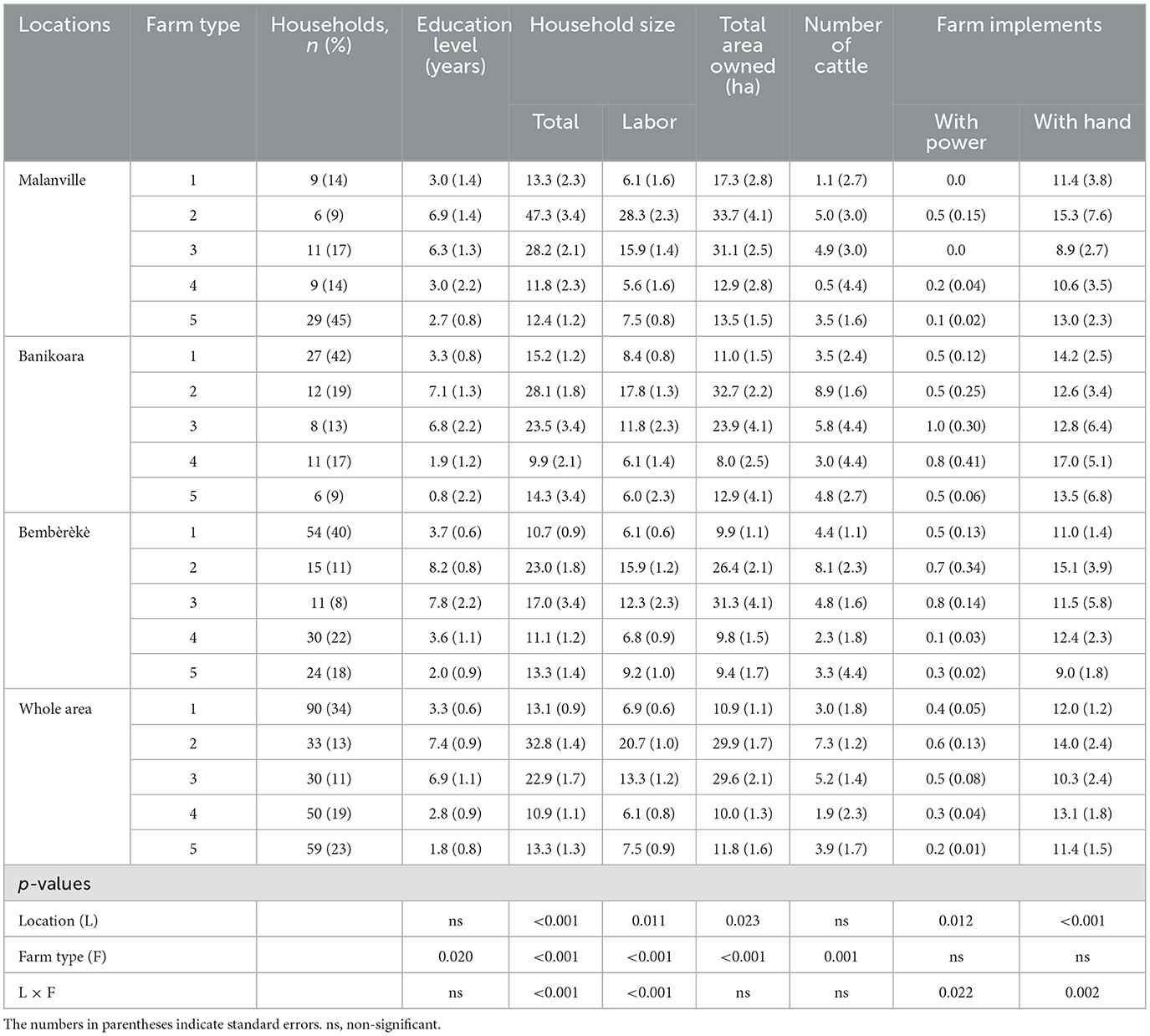
Table 3. Selected mean characteristics of households in the three study sites by location and farm type.
Among all food crops, maize acreage varies significantly between farm types. Overall, maize is the first major crop for all farm types, but the distribution pattern varies significantly within and between locations. In Banikoara, farms of types 1, 4, and 5 (55%−60% of total cropped land) grow more maize than farm types 2 and 3, while in Bembèrèkè, farm types 1, 2, 4, and 5 grow more maize (34%−49% of total cropped land) than farm types 3 (18.5% of total cropped land). Farms of type 1, 4, and 5 in Banikoara grow more maize (55%−60%) than their homologs in Bemberèkè and Malanville (36%−42%).
Cotton is the sole cash crop for all farm types. Overall, farm types 2 and 3 allocated more land to cotton (48.7% of total cropped land) than farm types 1, 4, and 5 (22%−25%). Farmers of type 1 in Banikoara allocated less land to cotton (14%) than the same farm type in Bemberèkè and Malanville (27%−34%), while farmers of type 5 in Banikoara and Bemberèkè allocated less land to cotton (13.5%) than the same types of farmers in Malanville (29%). Overall, the household income from maize production is higher in farm types 3 and 5 (60%−76%) than in farm types 1, 2, and 4 (15%−37%).
3.3 Resource endowment and use of soil fertility management practices
3.3.1 Traditional soil fertility management practices
The most common practices are outlined in Table 5. Except corralling practice, crop residue restitution, and legume–cereal rotation/intercropping (p < 0.05), the level of use of these practices did not differ between study areas (p > 0.05). In the whole study area, a large number of farmers (95.4%) occasionally or regularly use mineral fertilizers. Manure was applied exclusively to food crops through transporting and corralling. Of farmers, 16.8% use transported farmyard manure as fertilizer. On average, 9% of the surveyed farmers corral their farms in the study area, but this practice is used more in Malanville (11%) and Banikoara (9.8%). Most of the farmers practicing crop rotation (28.9%) mainly involve three crops (maize and cotton or legumes), whereas some have a broader range of choices. Because maize and cotton are the major crops in the farming systems in northern Benin, most of the time, the other crops are cultivated in association or rotation with the main crops. The average length of one crop rotation cycle is 2.5 years. Reportedly, 29.7 and 17.2% of farmers leave their crop residue on the fields after harvest, respectively, in Malanville and Bembèrèkè study areas, while only 4.7% report this practice in Banikoara. Only 15.5% of the surveyed farmers in the study area completely fallow their fields for three or more years. This decline in the installment of fallows is due to the decreasing availability of arable land within the territory of northern Benin. In Banikoara, where the cropping intensity is highest due to the cotton crop, fields are subject to partial fallow much more frequently than fields located in the other localities. On average, 8% of farmers use legume–maize rotation/intercropping. The actual use of soil fertility management practices does not show a significant difference between farm types, except for the use of crop residue restitution, legume–cereal rotation/intercropping, and cotton–maize rotation, where significant differences are observed (p < 0.05). Farmers of type 2 (15.2%), 4 (18.0%), and 5 (33.9%) apply more crop residue than farm types 1 and 3. More than 60% of farmers in farm type 1 and 2 use more legume–cereal rotation/intercropping practices than others. The levels of use of cotton-cereal rotation are significantly higher in farm type 5 (28.8%) than in other farm types. Despite of the absence of a significant difference, farmers of type 2 and 5 use the practice of corralling (8.8%) more than the others (4.4%).
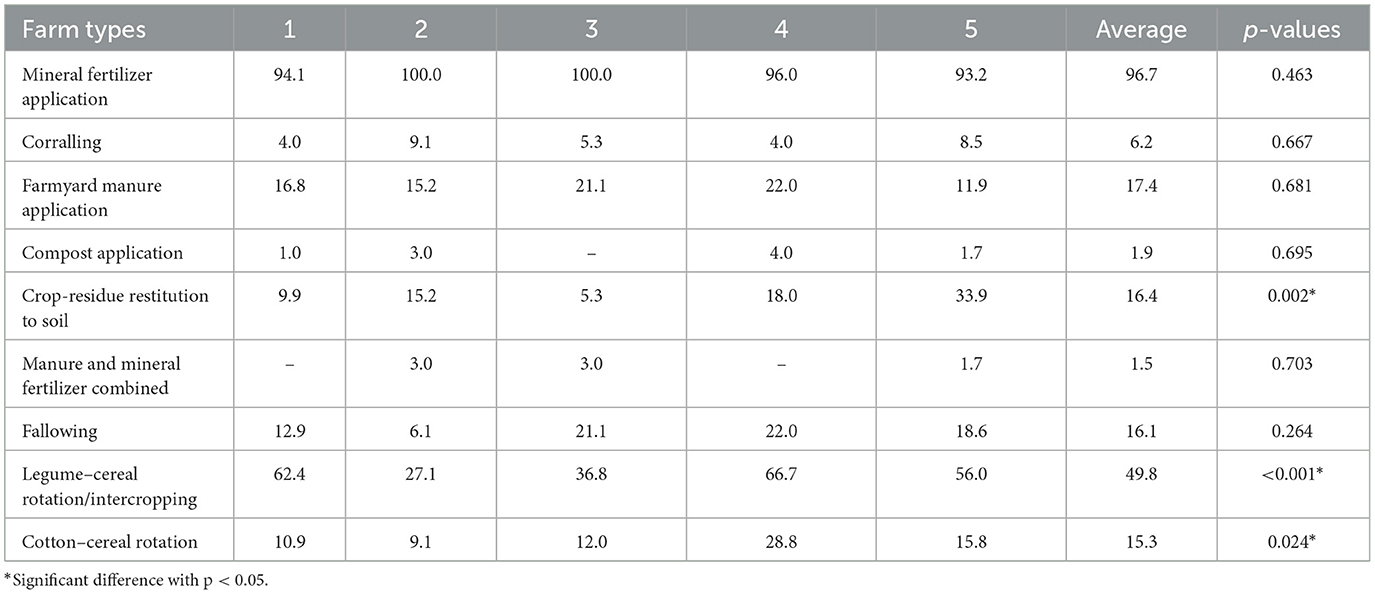
Table 5. Descriptive statistics of current use of soil fertility management practices (% of respondents).
3.3.2 Organic and mineral fertilization practices
Organic manure is obtained principally from cattle. In the study zone, organic manure is used in three principal forms: collection and transporting of farmyard manure to the farm, overnight corralling of cattle in the late dry season, and stubble grazing after harvest, of which the importance varies according to farmers’ categories. The collection of cattle manure consists of collecting the dung either at the residence place of the owner or with the “Fulani” camping and transporting them to the piece of farm to be manured. The owners who have cattle can collect dung in their cowsheds. The dung obtained in this case is mixed with crop residues and other animal dung (sheep, goats, etc.) and then transported to the piece of farm to be manured. In the five farm types, 12%−22% report applying the farmyard manure by transporting, but the amounts are difficult to quantify as the application was not systematic. In the whole study area, although it is recommended that the manure be broadcast at the plowing time, the manure management practices in northern Benin reveal various facets. In general, the dung mainly transported by cart, bag, wheelbarrows, and polyester bags is placed in heaps, sun-dried during the dry season, and then broadcast at 60%−80% of dry matter (based on results from another experiment) with a hoe on soil surface after the first rains just before plowing. More than 80% of farmers who apply farmyard manure use this method. Another application method was observed among 8.5% of farmers and involves collecting dung and burning it directly on the fields that are to be manured. Some farmers, mainly the poorly resourced farmers who have some cows, also apply small quantities of manure by point placement after plant emergence (6.4%). The manure quantity applied showed a significant difference between farm types (p < 0.001; Figure 2). Overall, farmers of types 1 and 2 use more manure in these maize fields (3,289.1 ± 415.9 kg ha−1 on average) than farmers of types 4 and 5 (2,473.4 ± 429.9 kg ha−1) and farm type 3 (984.2 ± 489.1 kg ha−1). We can separate farmers into three groups; a lower quantity group that could afford < 2 t ha−1, a medium-quantity group that could afford 2–4 t ha−1, and a higher quantity group that could afford more than 4 t ha−1.
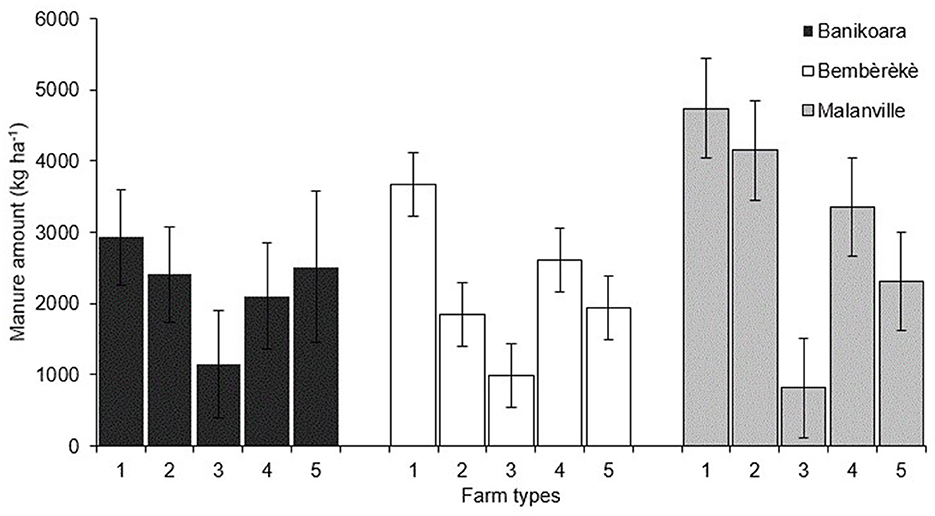
Figure 2. Average farmyard manure amount at farm scale across different farm types in three localities of Benin.
Overnight corralling in the late dry season remains the main traditional form of dung use by the wealthy and medium-resourced farmers, considering that they need to own livestock or be able to afford to pay the Fulani for the manure contract. The animals are corralled on farmers’ fields overnight after daytime grazing of rangeland during a few months (January–April) before the last plowing to ensure direct dropping of feces and urine on the field. Crop-residue grazing after harvest is primarily carried out by poorly resourced farmers. Thus, the farmers, in particular those who do not have animals or who keep a small number of animals, establish a stubble-grazing contract with Fulani herders. Crop residues and grasses on the harvested fields are important feed sources for livestock during the dry season. Maize fields are grazed in the dry season by the transhumant herds from Burkina Faso, Niger, and Nigeria. This contract makes it possible for the herdsmen to feed their animals with crop residue, especially during the dry periods of welding and scarcity of pasture, and for the farmers to bring cow dung to their fields.
The farmers use mainly three different mineral fertilizer application practices in their maize fields: a single use of compound NPK (43.5%), mainly the cotton formula; a single use of urea (41.9%); and a mixed application of the two fertilizers (53.4%; Table 6). The quantity applied did vary significantly between study locations for each practice (p > 0.05). Only the NPK and mix NPK-urea quantities vary significantly between farm types (p < 0.05). NPK application rates average 146.7 ± 10.9 kg ha−1 (farm type 2) and 166.6 ± 10.3 kg ha−1 (farm type 3) compared to 3.9 ± 6.5 kg ha−1 and 136.5 ± 7.0 kg ha−1 in the farm types 1 and 5, respectively. The amount of NPK applied is lowest with farm type 4 (94.7 ± 7.6 kg ha−1). The quantity of urea applied ranges between 46.1 and 78.1 kg ha−1 across sites and farm types. On average, farmers apply NPK and urea at 22 ± 8 and 44 ± 5 days after sowing, respectively. The methods of application are mainly broadcasting around the planting hill or top dressing without incorporation (95.3%), except for urea, in which the application is immediately followed by weeding and ridging (at application or the day after application).
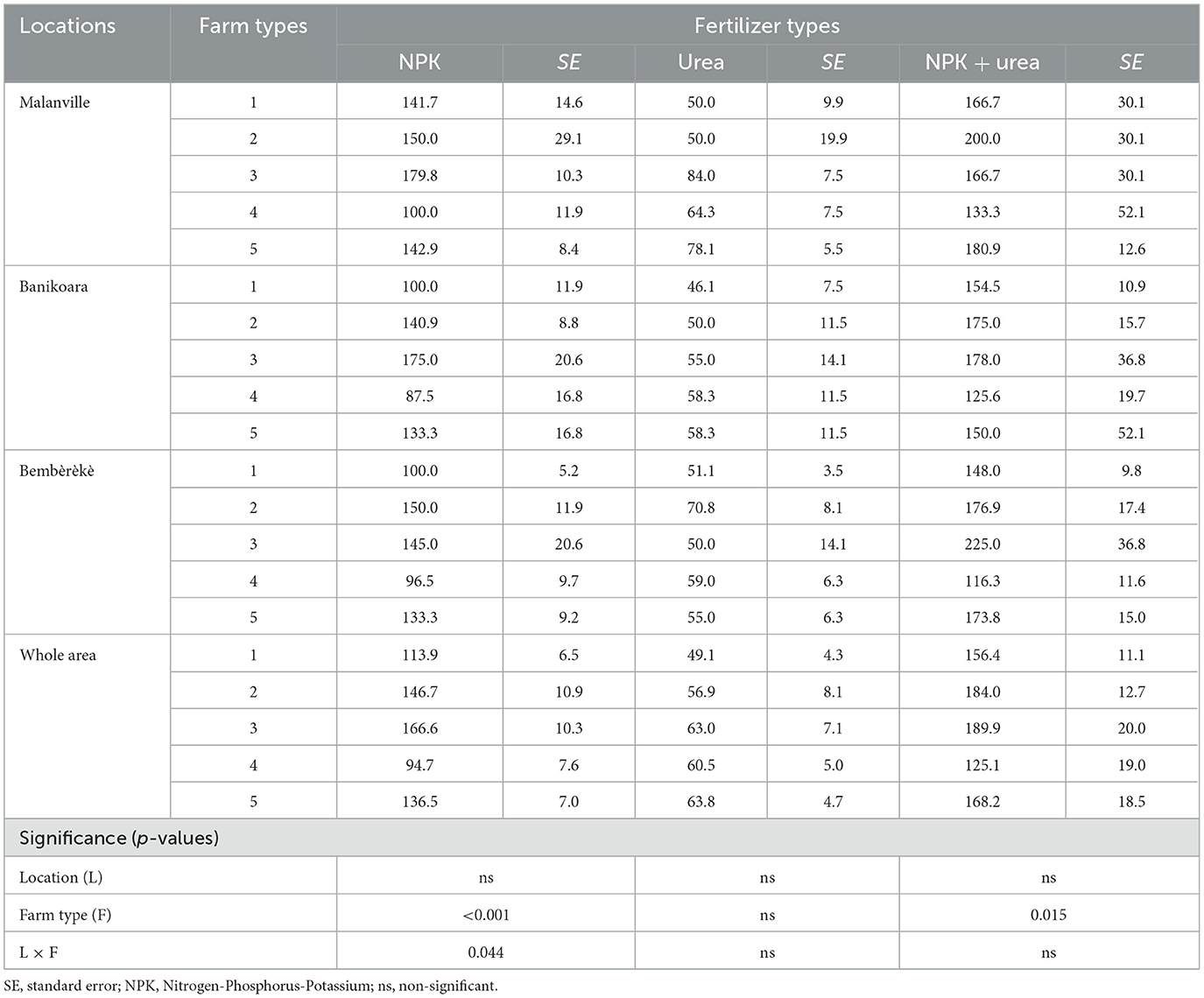
Table 6. Mineral fertilizer use (kg ha−1) for various descriptive statistics of current use of soil fertility management practices (% of respondents) across sites.
4 Discussion
4.1 Diversity of farming systems
Our study shows that the main influencing variables to classify farm types are the size of the farm and the percentages of total yearly income coming from maize, cotton, and off-farm activities. Personal observations and results from the focus group discussions with farmers concur that farmers prefer to distinguish themselves according to their main farming activities, being cotton farmers, maize farmers, or mixed farmers with both perennial crops and multiple annual crops.
In this study, human capital is described here by household size, household head age, education level, and family labor. The better and medium-resourced farms tended to have higher education levels, larger household sizes, and more family labor than the poorly resourced farmers. A majority of household heads are within the economically productive age range (20–64 years) of the country, indicating that most of the households are economically viable. Human capital is also related to ownership of assets and increased knowledge and experience (Kamanga et al., 2009). According to Kamanga et al. (2009), older farmers are considered more experienced and knowledgeable, and better resourced farmers tend to be better educated than the other groups. Educated farmers are often rational in decision-making concerning the timeliness of farm operations as well as the synchronization of major practices such as fertilizer application and weeding crops during growth stages. The size of the different farm types ranges between 12 and 18 ha, with an average of 15 ha over the total sample. Most farmers in the study area own more than 3.0 ha of land. This contrasts with farmers from the southern part of Benin, where most farmers own < 3.0 ha of land due to population pressure (Yemadjè et al., 2012). Better resourced farmers owned the largest fields, up to 18 ha in size. Yegbemey (2014) reported average crop areas of 14 ha in a survey carried out in maize cropping systems in northern Benin. In this study, better resourced farmers also owned the largest numbers of livestock with herds of up to eight head of cattle. The cattle numbers in the better resourced farmer group were similar to the numbers recorded by Yegbemey (2014) in the same study area. The better resourced households owned enough cattle that allowed them to use draft power for both farming and manure transport to field plots. The medium-resourced class owned at least four head of cattle. This is lower than that observed by Yegbemey (2014) for the modest farmers (six heads of cattle). The poorly resourced farmers have many constraints. They have fewer than two cattle, and they do not own large farm implements, such as a plow and scotch cart. Most of the time, farmers in northern Benin do not invest in only one crop. Approximately 20% of the farmers grow maize only. In that case, they rely on their wives or other household dependents to provide complementary crops (food) or buy them from the market. Furthermore, growing only one crop does not make it easy to implement crop rotation. To reduce risk aversion, farmers invest in more crops so that the very good yields of some might compensate for the failure of others. For 80% of the respondents, the average number of crops grown by farmers is three (i.e., often maize, cotton, and yam). Poor farmers grow a diversity of crops, ranging between six and eight different crops, but they cannot afford to do so because they have less land, less access to inputs and thus need to dedicate a greater proportion of their land to maize (or the main cash crop, cotton). Households from all wealth classes planted, consumed, and marketed important amounts of maize. Wealthier households planted larger maize acreages and earned more income from maize marketing than poorer households, while the share of cropped land planted to maize and the importance of maize as a food crop did not vary between wealth classes. Considering that, in the past years, northern Beninese farmers still regarded maize as “food for very poor people,” there has been a considerable evolution in this thought, whereby large acreages are increasingly farmed even more than in the southern areas. This study shows that maize is not a poor people’s crop in northern Benin when evaluated on absolute acreages planted or absolute income earned. At a regional scale, we did not find evidence that maize is produced in “poverty pockets.” Thus, classifying maize as the crop for the poor people in northern Benin is too simplistic. This may be a historical perception from colonial times, when farmers had no limits on their access to land and could plant larger yam acreages, which was the main staple food crop in this region a few years ago.
4.2 Resource endowment and soil fertility management practices by farmers
A higher proportion of farmers use inorganic fertilizers. Inorganic fertilizers are widely adopted because of the immediate returns observed after application. However, application rates in the region are still low for most resource-poor farmers. Farmers with more available resources were involved more in applying mineral fertilizers, as mentioned also by Pender and Ruben (2004). Despite the recognized need to apply mineral fertilizers for high yields, the intensity of use in SSA, in general, and West Africa, in particular, is limited by the lack of capital, inefficient distribution systems, poor enabling policies, and other socioeconomic factors (Kormawa et al., 2003; Abdoulaye and Sanders, 2005; Morris et al., 2007). Low-cost means of improving soil fertility and productivity are therefore necessary.
Most resource-poor farmers practicing crop rotation mainly involve two crops (maize and cotton), whereas some have a broader range of choices. With maize and cotton being the major crops in the farming systems of northern Benin, most of the time, the other crops are cultivated in association/rotation with the main crops. Our result confirms those of Kindomihou et al. (2007), who observed that farming associations in northern Benin highlighted cereal–leguminous systems outside of mineral fertilizer use and the successions of cotton/cereal and cereal/leguminous/cereal systems. Thus, the perception that poorer farmers use intercropping to reduce the risk of crop failure by maximizing returns to land and labor (Fermont et al., 2009) can be confirmed in the sense that poorer households intercrop maize more than wealthier households (Table 4).
As for the other practices, it should be noted that 17% of farmers use transported farmyard manure as fertilizer. This proportion is much lower than those previously reported in West Africa (Harris and Yusuf, 2001; Hoffmann et al., 2001; Osbahr and Allan, 2003). The problem of manure transport is that it is mainly responsible for the low proportion of manually manured fields (Diogo et al., 2013). On average, 9% of the surveyed farmers corral their farms in the study area, with a relatively high proportion in Malanville and Banikoara. This could be explained by the contract of corralling with the transhumant herders of the Peulh ethnic group, who come from Niger, Nigeria, and Burkina Faso. This proportion is lower than that reported by Schlecht and Buerkert (2004) in western Niger (13%). According to Powell et al. (1998), this form of manure management is preferable to the application of transported manure because of the feed availability for livestock herds, the additional benefits of urine, and the nutrient-loss risk minimization. Many studies have highlighted the role of the transhumant herds in maintaining soil fertility in the mixed crop–livestock systems of West Africa, mostly in the Sudano–Sahelian zone (Schlecht et al., 2004). For poorly resourced farmers, manure or mineral fertilizer is primarily applied to cotton and, occasionally, cereals, mainly to maize. The combined applications of manure and mineral fertilizer is practiced only with the better resourced farmers (80%).
The levels of use of crop-residue restitution and cotton–cereal rotation are significantly higher in the medium-resourced (40 and 27%, respectively) and poorly resourced (42 and 59%, respectively) farms than the better resourced farms (18 and 15%, respectively). Reportedly, 17.2 and 29.7% of farmers leave their crop residues on the fields after harvest in Banikoara and Bembèrèkè, respectively, while only 4.7% report using this practice in Malanville. Crop residue is principally grazed in situ by livestock; also, a number of farmers export both the grain and stover from their fields. However, this latter practice is not carried out by poorly resourced households that lack draft animals or carts for transport. These proportions are much lower than the 36%−84% of the mulched fields reported from a previous survey in Niger (Schlecht and Buerkert, 2004; Schlecht et al., 2004). In this area, the application of crop residue mulch during the dry season is a method frequently advocated (Bationo et al., 1995; Buerkert and Lamers, 1999; Buerkert et al., 2000; Akponikpè et al., 2008). Crop residues constitute the main potential sources of slowly released plant nutrients in the Sahel to prevent nutrient depletion and preserve the long-term productivity of soils.
Only 16% of the surveyed farmers in the study area (mainly the better resourced farmers for 80%) completely fallow their land for three or more years. This decline in the installment of fallows is due to the decreasing availability of arable land within northern Benin. In Banikoara, where the cropping intensity is highest due to the cotton crop, fields are subjected to partial fallow much more than other zones.
4.3 Constraints and opportunities for adopting improved soil fertility management practices
Our survey results indicate that low organic fertilizer use remains a serious challenge in the study areas, coupled with the relatively low level of mineral fertilizer use and the implementation of better fertilization practices. There is an urgent need to find effective ways to aid farmers in cost-effective, rational, and integrated fertilization strategies. Most farmers have ceased the traditional practices of applying organic fertilizers such as farmyard manure, overnight corralling of cattle, and green manure (maize–legume intercropping/rotation). Based on the effects of decreasing soil fertility, many farmers apply more mineral fertilizers for compensation (Giller et al., 2011; Vanlauwe et al., 2014). Knowing the effectiveness of these practices (Suzuki et al., 2014; Bielders and Gérard, 2015), improving these traditional organic fertilization practices in the maize-based farming system of northern Benin may be an effective way to increase maize productivity and improve food security and smallholder household income. Many research efforts in SSA have been conducted to improve soil fertility management in smallholder agricultural systems. These practices include using small amounts of manure in hill planting (Ncube et al., 2009); small doses of mineral fertilizer in planting hill at sowing termed “microdosing,” “micro fertilization,” or “hill placement” (Buerkert et al., 2001; Bielders and Gérard, 2015); and a combination of a small amount of organic manure and mineral fertilizer (Ibrahim et al., 2015a,b). Before testing or developing new technologies, knowing their potential adoption across farm types is useful. Several studies have shown that many variables, such as resource availability (land, labor, and cash), influence adoption potential of agricultural practices among smallholder farms in Africa (Franzel et al., 2001; Twomlow and Ncube, 2001; Tittonell et al., 2005a,b; Zingore et al., 2006; Bidogeza et al., 2009; Kamanga et al., 2009; Bongers et al., 2015). Our survey results reveal that, despite the variability of both socioeconomic and management characteristics among farm types, many similarities in soil fertility management behaviors and attitudes exist and should be incorporated into the research and development of agricultural programs.
Opportunities exist in all farm types to adopt improved soil fertility management practices; however, the constraints vary across farm types. All farm types are potential adopters of the organic manuring practice (farmyard manure, overnight corralling of cattle, green manure, and their residual effects). Using farmyard manure in maize fields depended on manure availability within the farm and the village and the accessibility of farmers to procure it, which also depends on the availability of transport material. According to Schlecht et al. (1995, 1998) and Powell et al. (1996), the dung voided per TLU per day was assumed to amount to 2.2 kg of dry matter when stubble grazing and corralled on the field. In the present study, the potential amount of organic manure available from cattle corralling was, on average, 2.4, 5.9, 4.2, 1.5, and 3.1 t ha−1 in farm types 1, 2, 3, 4, and 5, respectively. Accordingly, possessing two cattle that could be rotated for 1–2 months can make it raising the soil fertility level as quickly as possible. The recommended rate of farmyard organic manure, either animal manure or green manure together, in maize fields is 6.0 t ha−1 (Dagbenonbakin, 2005). Farmyard manure can be used more in farm types 2 and 3 than the others but at lower rates than recommended. Farmers in farm types 1 and 4 have less organic manure as they have fewer animals than other farmers.
The corralling practice will be more profitable for farmers who have fewer resources and less cash, mostly because of its residual effect in the short and medium terms (Suzuki et al., 2014; Bielders and Gérard, 2015). Most farmers of type 4 cannot apply farmyard manure to maize as they have no cattle. This category of farmers can establish a stubble-grazing contract with Fulani herders. This contract makes it possible for the herdsman to, in particular, nourish their animals with crop residue in periods of welding and scarcity of pasture and for the farmer to bring cow dung into their field. Farm types 2 and 3, which are relatively wealthy, have significantly more land and labor available than the other farm types. Maize yields and revenues are high, and the current use of improved soil nutrient management is significantly higher than for other farm types. The current high use of a high rate of mineral fertilizer indicates that it seems to fit well with this farm type, and its adoption potential seems high. Also, as land and labor availability are high and maize yield and revenue are high, the adoption potential of the new proposed practices, such as hill placement of manure/mineral fertilizer and the reduced use of manure/mineral fertilizer quantity in hill planting, might be low for these farm types. Creating awareness and demonstrating the effectiveness of these practices in these farms (mostly with their permanently hired laborers because farmers in these farm types do not fertilize their fields themselves) may influence adoption. Moreover, the combined use of manure and mineral fertilizer might be high for these farm types.
Farm types 2 and 3 mostly rely on off-farm activities for their income, and investments in maize production seem to be limited. The adoption potential of new proposed practices such as hill placement of manure/mineral fertilizer and the reduced use of manure/mineral fertilizer quantity in hill planting might be high for these farm types. Moreover, the combined use of manure and mineral fertilizer might be low for these farm types. Farm type 4, the poorly resourced farms, has limited labor resources but less land and significantly less cash (low cash crop acreage) available. The unavailability of cash makes it impossible for this farm type to hire labor. With the main source of income coming from maize production, investments in cotton production, the cash crop, seem to be limited. The adoption potential of the recommendations to enhance maize yield and improve soil nutrient management and fertility seems to be low.
In summary, the adoption potential of the different possible fertilizer and manure recommendations differ between farm types. Farmers who have the most livestock and members who have access to more manure, transport, and labor implement more soil fertility management practices than other farmers. Having more resources, a rich farmer is better able to invest in soil fertility management than a poor farmer. The collection of manure can be very labor-intensive, especially when the household does not have cattle and the farmer has to collect manure in the bush. For mineral fertilizer, this is probably the only labor cost involved, although additional efforts are required to transport fertilizer from the market to the fields. In our study area, for farmers who do not grow cotton, mineral fertilizer is not always easily available in their village. In addition to labor, a cash or in-kind payment may also be required. Sometimes credit is available, but cash is still needed eventually to pay off the credit. An in-kind or cash payment is also necessary for parking the animals of the Peulh ethnic group.
Future research should target the development of new, cost-effective, easy-to-use soil fertility management technologies that can enhance the efficiency of both organic and inorganic fertilizers. The developed technology should also be culturally acceptable to smallholder farmers to enhance adoption. Furthermore, broader studies encompassing different agroecological regions and larger and more diverse samples are needed to fully understand and address the challenges of soil fertility management in maize and other widely grown crops in SSA.
4.4 Implication for policymakers in the adoption of sustainable soil fertility practices
The findings from this study emphasize the crucial role of policymakers in the adoption of sustainable soil fertility management in West Africa. The region’s agroecological diversity, alongside varying resource endowments and demographics of farm households in the region, calls for a nuanced approach to formulating and executing agricultural policies and investments. This research accentuates the urgent necessity for policy frameworks that not only acknowledge but also robustly support the agrobiodiversity and indigenous knowledge systems intrinsic to these farming communities. Policymakers should allocate priority to investments in agricultural research and development. Such investments should target the promotion of sustainable farming practices and the enhancement of climate resilience. Moreover, policy initiatives ought to aim at augmenting farmers’ understanding and management of agrobiodiversity, thus reinforcing the resilience of farming systems against the negative impact of climate change. In addition, the need for policy amendments that facilitate smallholder farmers’ access to markets, credit, and improved inputs, thereby enabling them to navigate farming risks and elevate their economic well-being more effectively, is urgent. Such policies must incorporate farmers’ typology, perceptions, and insights into the agricultural policymaking process to yield more effective and sustainable solutions.
This study could have benefited from examining the role of policies and institutional framework in promoting the adoption of improved soil fertility management practices. This may include subsidy programs, extension services, and farmer education programs.
5 Conclusion
This study characterizes the maize farming system using farm typology and points out the relationship between prosperity level and the way soil fertility is managed in northern Benin. Farms differ in land, labor, and financial resources and in potential nutrient availability, which affects land use and soil fertility management. Maize-based farming systems in northern Benin integrate diverse practices for soil fertility management, such as (1) “traditional” (fallow, corralling, farmyard manure application, legume–cereal rotation/intercropping, cotton–cereal rotation, etc.) and (2) “improved” (mineral fertilizer application, composting, integrated manure and fertilizer use, etc.). The main practice to improve/maintain soil fertility was mineral fertilizer and manure application, but the rates are far below those recommended or required to ensure good maize yields. The study has found that a smallholder farmer’s soil fertility management is directly determined by the level of resources of the household, which influences the amounts of mineral fertilizer and manure that the household can use. The amount of fertilizer and manure that is available and affordable varies greatly between study zones and farm types. Development strategies, interventions, and policies aiming at increasing maize production and reducing poverty in northern Benin should be tailored to these farm types. This should target individual farm systems to achieve their goals. With subsistence farming being the most important to the poor, improving soil fertility for maize production in these farms will directly enhance their lives. In the transition to sustainable production systems, fertilizing using locally available resources could be well developed and the constraints to manure transportation could be lifted. This research recommends a combination of soil fertility technologies, including integration of traditional soil organic manure management practices, small amounts, and a judicious application method of fertilizer and manure, and their risks and adoption by smallholder farmers.
Data availability statement
The raw data supporting the conclusions of this article will be made available by the authors, without undue reservation.
Author contributions
PT: Writing – review & editing, Writing – original draft, Visualization, Resources, Project administration, Methodology, Investigation, Funding acquisition, Formal analysis, Data curation, Conceptualization. ES: Validation, Writing – review & editing, Visualization, Supervision, Methodology, Investigation, Formal analysis. JE: Writing – review & editing, Visualization, Validation, Supervision, Software, Methodology, Investigation, Formal analysis. EA: Writing – review & editing, Visualization, Validation, Supervision, Software, Methodology, Investigation, Formal analysis. PA: Writing – review & editing, Visualization, Validation, Supervision, Methodology. JY: Writing – review & editing, Visualization, Validation, Supervision, Methodology.
Funding
The author(s) declare financial support was received for the research, authorship, and/or publication of this article. This study was funded by the West Africa Agricultural Productivity Program (WAAPP-Benin).
Acknowledgments
The authors are grateful to the farmers for participating in this study, the field enumerators who helped collect the data, and the reviewers for useful comments. The authors acknowledge the West Africa Agricultural Productivity Program (WAAPP-Benin) for their financial support for this study.
Conflict of interest
The authors declare that the research was conducted in the absence of any commercial or financial relationships that could be construed as a potential conflict of interest.
Publisher’s note
All claims expressed in this article are solely those of the authors and do not necessarily represent those of their affiliated organizations, or those of the publisher, the editors and the reviewers. Any product that may be evaluated in this article, or claim that may be made by its manufacturer, is not guaranteed or endorsed by the publisher.
Supplementary material
The Supplementary Material for this article can be found online at: https://www.frontiersin.org/articles/10.3389/fsrma.2024.1354981/full#supplementary-material
References
Abdoulaye, T., and Sanders, J. H. (2005). Stages and determinants of fertilizer use in semiarid African agriculture: the Niger experience. Agric. Econ. 32, 167–179. doi: 10.1111/j.0169-5150.2005.00011.x
Akossou, A. Y., Attakpa, E. Y., Fonton, N. H., Sinsin, B., and Bosma, R. H. (2016). Spatial and temporal analysis of maize (Zea mays) crop yields in Benin from 1987 to 2007. Agric. For. Meteorol. 220, 177–189. doi: 10.1016/j.agrformet.2016.01.143
Akponikpè, P. B. I., Michels, K., and Bielders, C. L. (2008). Integrated nutrient management of pearl millet in the sahel combining cattle manure, crop residue and mineral fertilizer. Exp. Agric. 44, 453–472. doi: 10.1017/S001447970800673X
Azouma, O. Y., Giroux, F., and Varchon, D. (2007). Conception d’un épandeur de fumures organiques pour les exploitations à traction animale d’Afrique. Tropicultura 25, 75–81.
Barrett, C. B., and Bevis, L. E. M. (2015). The self-reinforcing feedback between low soil fertility and chronic poverty. Nat. Geosci. 8, 907–912. doi: 10.1038/ngeo2591
Bationo, A., Buerkert, A., Sedogo, M. P., Christianson, B. C., and Mokwunye, A. U. (1995). “A critical review of crop-residue use as soil amendment in the West African semi-arid tropics,” in International Conference on Livestock and Sustainable Nutrient Cycling in Mixed Farming Systems of Sub-Saharan Africa. Addis Ababa (Ethiopia) 22-26 Nov 1993.
Bidogeza, J. C., Berentsen, P. B. M., De Graaff, J., and Lansink, A.O. (2009). A typology of farm households for the Umutara Province in Rwanda. Food Secur. 1, 321–335. doi: 10.1007/s12571-009-0029-8
Bielders, C. L., and Gérard, B. (2015). Millet response to microdose fertilization in south–western Niger: effect of antecedent fertility management and environmental factors. Field Crops Res. 171, 165–175. doi: 10.1016/j.fcr.2014.10.008
Bongers, G., Fleskens, L., Van de Ven, G. D., Giller, K. E. N., and Van Asten, P. (2015). Diversity in smallholder farms growing coffee and their use of recommended coffee management practices in Uganda. Exp. Agric. 51, 1–21. doi: 10.1017/S0014479714000490
Buerkert, A., Bationo, A., and Dossa, K. (2000). Mechanisms of residue mulch-induced cereal growth increases in West Africa. Soil Sci. Soc. Am. J. 64, 346–358. doi: 10.2136/sssaj2000.641346x
Buerkert, A., Bationo, A., and Piepho, H. P. (2001). Efficient phosphorus application strategies for increased crop production in sub-Saharan West Africa. Field Crops Res. 72, 1–15. doi: 10.1016/S0378-4290(01)00166-6
Buerkert, A., and Lamers, J. P. A. (1999). Soil erosion and deposition effects on surface characteristics and pearl millet growth in the West African Sahel. Plant Soil 215, 239–253. doi: 10.1023/A:1004755731732
Carsky, R. J., Becker, M., and Hauser, S. (2001). “Mucuna cover crop fallow systems: potential and limitations,” in Sustaining Soil Fertility in West Africa, Vol. 58, eds. G. Tian, F. Ishida, and D. Keatinge (Madison, WI: Soil Science Society of America and American Society of Agronomy, Special Publication), 111–135. doi: 10.2136/sssaspecpub58.ch6
Dagbenonbakin, G. D. (2005). Productivity and water use efficiency of important crops in the Upper Oueme catchment: influence of nutrient limitations, nutrient balances and soil fertility [Dissertation]. University of Bonn, Bonn.
Diogo, R. V., Schlecht, E., Buerkert, A., Rufino, M. C., and van Wijk, M. T. (2013). Increasing nutrient use efficiency through improved feeding and manure management in urban and peri-urban livestock units of a West African city: a scenario analysis. Agric. Syst. 114, 64–72. doi: 10.1016/j.agsy.2012.09.001
Fermont, A. M., Van Asten, P. J., Tittonell, P., Van Wijk, M. T., and Giller, K. E. (2009). Closing the cassava yield gap: an analysis from smallholder farms in East Africa. Field Crops Res. 112, 24–36. doi: 10.1016/j.fcr.2009.01.009
Franzel, S., Coe, R., Cooper, P., Place, F., and Scherr, S. J. (2001). Assessing the adoption potential of agroforestry practices in sub-Saharan Africa. Agric. Syst. 69, 37–62. doi: 10.1016/S0308-521X(01)00017-8
Giller, K. E., Tittonell, P., Rufino, M. C., Van Wijk, M. T., Zingore, S., Mapfumo, P., et al. (2011). Communicating complexity: integrated assessment of trade-offs concerning soil fertility management within African farming systems to support innovation and development. Agric. Syst. 104, 191–203. doi: 10.1016/j.agsy.2010.07.002
Harris, F., and Yusuf, M. A. (2001). Manure management by smallholder farmers in the Kano close-settled zone, Nigeria. Exp. Agric. 37, 319–332. doi: 10.1017/S0014479701003040
Hoffmann, I., Gerling, D., Kyiogwom, U. B., and Mané-Bielfeldt, A. (2001). Farmers management strategies to maintain soil fertility in a remote area in northwest Nigeria. Agric. Ecosyst. Environ. 86, 263–275. doi: 10.1016/S0167-8809(00)00288-7
Husson, F., Josse, J., and Pagès, J. (2010). Principal component methods–hierarchical clustering – partitional clustering: why would we need to choose for visualizing data? Technical Report–Agrocampus. 1–17.
Ibrahim, A., Abaidoo, R. C., Fatondji, D., and Opoku, A. (2015a). Hill placement of manure and fertilizer microdosing improves yield and water use efficiency in the Sahelian low input millet-based cropping system. Field Crops Res. 180, 29–36. doi: 10.1016/j.fcr.2015.04.022
Ibrahim, A., Abaidoo, R. C., Fatondji, D., and Opoku, A. (2015b). Integrated use of fertilizer microdosing and Acacia tumida mulching increases millet yield and water use efficiency in Sahelian semi-arid environment. Nutr. Cycling Agroecosyst. 103, 375–388. doi: 10.1007/s10705-015-9752-z
INSAE (2013). “Recensement Général de la Population et de l’Habitat,” Résultats Provisoires du RGPH4, MPPD (Cotonou), 7.
Kamanga, B. C. G., Waddington, S. R., Robertson, M. J., and Giller, K. E. (2009). Risk analysis of maize-legume crop combinations with smallholder farmers varying in resource endowment in central Malawi. Exp. Agric. 46, 1–21. doi: 10.1017/S0014479709990469
Kindomihou, V., Ambouta, K. J.-M., and Sinsin, B. (2007). “Diversity of soil fertility management practices in Sudanian Zones of Benin (Western Africa),” in Tropentag 2007 University of Kassel-Witzenhausen and University of Göttingen, October 9-11, 2007. Conference on International Agricultural Research for Development, 6.
Kormawa, P., Munyemana, A., and Soule, B. (2003). Fertilizer market reforms and factors influencing fertilizer use by small-scale farmers in Benin. Agric. Ecosyst. Environ. 100, 129–136. doi: 10.1016/S0167-8809(03)00181-6
Livingston, G., Schonberger, S., and Delaney, S. (2011). “Sub-Saharan Africa: the state of smallholders in agriculture,” in IFAD Conference on New Directions for Smallholder Agriculture (Rome: IFAD HQ), 25.
Mapfumo, P., and Giller, K. E. (2001). Soil Fertility Management Strategies and Practices by Smallholder Farmers in Semiarid Areas of Zimbabwe. Bulawayo: ICRISAT and FAO, 53.
Morris, M., Kelley, V. A., Kopicki, R. J., and Byerlee, D. (2007). Fertilizer use in subSahelian regions. J. Agric. Sci. 88, 12–16.
Ncube, B., Twomlow, S. J., Dimes, J. P., Van Wijk, M. T., and Giller, K. E. (2009). Resource flows, crops and soil fertility management in smallholder farming systems in semi-arid Zimbabwe. Soil Use Manag. 25, 78–90. doi: 10.1111/j.1475-2743.2009.00193.x
Osbahr, H., and Allan, C. (2003). Indigenous knowledge of soil fertility management in southwest Niger. Geoderma 111, 457–479. doi: 10.1016/S0016-7061(02)00277-X
Pender, J., and Ruben, R. (2004). Rural diversity and heterogeneity in less favourable areas: the quest for policy targeting. Food Policy 29, 303–320. doi: 10.1016/j.foodpol.2004.07.004
Powell, J. M., Fernandez-Rivera, S., Hiernaux, P., and Turner, M. D. (1996). Nutrient cycling in integrated rangeland/cropland systems of the Sahel. Agric. Syst. 52, 143–170. doi: 10.1016/0308-521X(96)00009-1
Powell, J. M., Ikpe, F. N., Somda, Z. C., and Fernandez-Rivera, S. (1998). Urine effects on soil chemical properties and the impact of urine and dung on pearl millet yield. Exp. Agric. 34, 59–276. doi: 10.1017/S0014479798343069
PSDSA (2017). Plan Stratégique de Développement du Secteur Agricole (PSDSA) 2025 et Plan National d’Investissements Agricoles et de Sécurité Alimentaire et Nutritionnelle PNIASAN 2017 – 2021, 30.
Saïdou, A., Kuyper, T. W., Kossou, D. K., Tossou, R., and Richards, P. (2004). Sustainable soil fertility management in Benin: learning from farmers. NJAS-Wagen. J. Life Sci. 52, 349–369. doi: 10.1016/S1573-5214(04)80021-6
Schlecht, E., and Buerkert, A. (2004). Organic inputs and farmers’ management strategies in millet fields of western Niger. Geoderma 121, 271–289. doi: 10.1016/j.geoderma.2003.11.015
Schlecht, E., Fernandez-Rivera, S., and Hiernaux, P. (1998). “Timing, size and N concentration of faecal and urinary excretions in cattle sheep and goats—can they be used for better manuring of cropland?” in Soil fertility management in West African Land Use Systems, eds. G. Renard, A. Neef, K. Becker, and M. von Oppen (Weikersheim: Margraf Verlag), 361–368.
Schlecht, E., Hiernaux, P., Achard, F., and Turner, M. D. (2004). Livestock related nutrientbudgets within village territories in western Niger. Nutr. Cycl. Agroecosyst. 68, 199–211. doi: 10.1023/B:FRES.0000019453.19364.70
Schlecht, E., Mahler, F., Sangaré, M., Susenbeth, A., and Becker, K. (1995). “Quantitative and qualitative estimation of nutrient intake and faecal excretion of zebu cattle grazing natural pasture in semi-arid Mali,” International Conference on Livestock and Sustainable Nutrient Cycling in Mixed Farming Systems of Sub-Saharan Africa, Addis Ababa (Ethiopia), 22-26 Nov 1993 (ILCA).
Smale, M., Byerlee, D., and Jayne, T. (2011). Maize revolutions in Sub-Saharan Africa. Policy Research Working Paper Series. Washington, DC: The World Bank. doi: 10.1596/1813-9450-5659
Smale, M., Byerlee, D., and Jayne, T. (2013). “Maize revolutions in Sub-Saharan Africa,” in An African Green Revolution: Finding Ways to Boost Productivity on Small Farms, eds. K. Otsuka, and D. F. Larson (Dordrecht: Springer), 165–195. doi: 10.1007/978-94-007-5760-8_8
Srivastava, A. K. (2010). Management Effects on Yam Production in Benin Republic-Experimental Analysis and Modeling [Doctoral dissertation]. Universitäts-und Landesbibliothek Bonn, Bonn.
Suzuki, K., Matsunaga, R., Hayashi, K., Matsumoto, N., Tabo, R., Tobita, S., et al. (2014). Effects of traditional soil management practices on the nutrient status in Sahelian sandy soils of Niger, West Africa. Geoderma 223, 1–8. doi: 10.1016/j.geoderma.2014.01.016
Tidjani, M. A., and Akponikpè, P. B. I. (2012). Evaluation des stratégies paysannes d’adaptation aux changements Climatiques:Cas de la production du maïs au Nord-Bénin. Afr. Crop Sci. J. 20, 425–441.
Tittonell, P., Muriuki, A., Shepherd, K. D., Mugendi, D., Kaizzi, K. C., Okeyo, J., et al. (2010). The diversity of rural livelihoods and their influence on soil fertility in agricultural systems of East Africa – a typology of smallholder farms. Agric. Syst. 103, 83–97. doi: 10.1016/j.agsy.2009.10.001
Tittonell, P., Vanlauwe, B., De Ridder, N., and Giller, K. E. (2007). Heterogeneity of crop productivity and resource use efficiency within smallholder Kenyan farms: soil fertility gradients or management intensity gradients? Agric. Syst. 94, 376–390. doi: 10.1016/j.agsy.2006.10.012
Tittonell, P., Vanlauwe, B., Leffelaar, P. A., Rowe, E. C., and Giller, K. E. (2005a). Exploring diversity in soil fertility management of smallholder farms in western Kenya: I. Heterogeneity at region and farm scale. Agric. Ecosyst. Environ. 110, 149–165. doi: 10.1016/j.agee.2005.04.001
Tittonell, P., Vanlauwe, B., Leffelaar, P. A., Rowe, E. C., and Giller, K. E. (2005b). Exploring diversity in soil fertility management of smallholder farms in western Kenya: II. Within-farm variability in resource allocation, nutrient flows and soil fertility status. Agric. Ecosyst. Environ. 110, 166–184. doi: 10.1016/j.agee.2005.04.003
Twomlow, S. J., and Ncube, B. (2001). Improving Soil Management Options for Women Farmers in Malawi and Zimbabwe Proceedings of a Collaborators’ Workshop on the DFID-supported Project” Will Women Farmers Invest in Improving their Soil Fertility Management? 13-15 September 2000. Bulawayo: International Crops Research Institute for the Semi-Arid Tropics.
Vanlauwe, B., Six, J., Sanginga, N., and Adesina, A. A. (2015). Soil fertility decline at the base of rural poverty in sub-Saharan Africa. Nat. Plants 1:15101. doi: 10.1038/nplants.2015.101
Vanlauwe, B., Wendt, J., Giller, K. E., Corbeels, M., Gerard, B., Nolte, C., et al. (2014). A fourth principle is required to define conservation agriculture in subSaharan Africa: the appropriate use of fertilizer to enhance crop productivity. Field Crops Res. 155, 10–13. doi: 10.1016/j.fcr.2013.10.002
Yegbemey, R. N. (2014). Adaptation to climate change and sustainable agriculture in West Africa: a case study of maize farming in Benin [PhD Thesis]. JustusLiebig University Giessen, Germany, Margraf Publishers, Weikersheim.
Yegbemey, R. N., Kabir, H., Awoye, O. H., Yabi, J. A., and Paraïso, A. A. (2014). Managing the agricultural calendar as coping mechanism to climate variability: a case study of maize farming in northern Benin, West Africa. Clim. Risk Manag. 3, 13–23. doi: 10.1016/j.crm.2014.04.001
Yemadjè, R. H., Crane, T. A., Vissoh, P. V., Mongbo, R. L., Richards, P., Kossou, D. K., et al. (2012). The political ecology of land management in the oil palm based cropping system on the Adja plateau in Benin. NJASWageningen J. Life Sci. 60, 91–99. doi: 10.1016/j.njas.2012.06.007
Zingore, S., Gonzalez-Estrada, E., Delve, R. J., Dimes, J. P., Herrero, M., Murwira, H. K., et al. (2006). “Evaluation of resource management options for smallholder farms using an integrated modelling approach,” in The International Association of Agricultural Economists Conference (Gold Coast, QLD).
